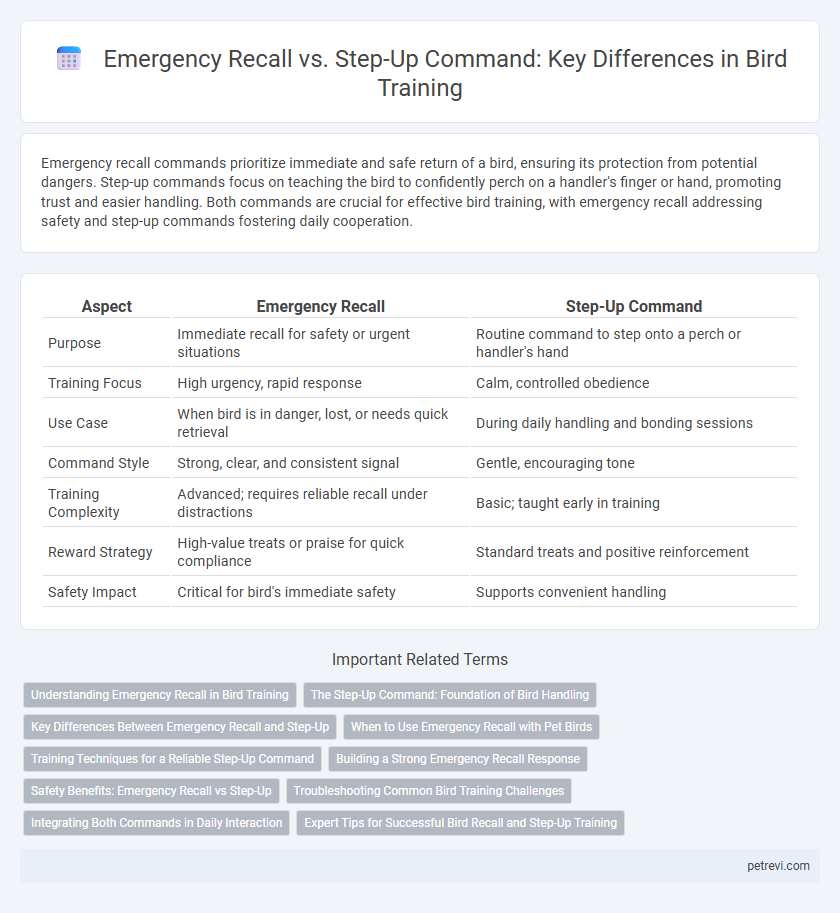Emergency recall commands prioritize immediate and safe return of a bird, ensuring its protection from potential dangers. Step-up commands focus on teaching the bird to confidently perch on a handler's finger or hand, promoting trust and easier handling. Both commands are crucial for effective bird training, with emergency recall addressing safety and step-up commands fostering daily cooperation.
Table of Comparison
| Aspect | Emergency Recall | Step-Up Command |
|---|---|---|
| Purpose | Immediate recall for safety or urgent situations | Routine command to step onto a perch or handler's hand |
| Training Focus | High urgency, rapid response | Calm, controlled obedience |
| Use Case | When bird is in danger, lost, or needs quick retrieval | During daily handling and bonding sessions |
| Command Style | Strong, clear, and consistent signal | Gentle, encouraging tone |
| Training Complexity | Advanced; requires reliable recall under distractions | Basic; taught early in training |
| Reward Strategy | High-value treats or praise for quick compliance | Standard treats and positive reinforcement |
| Safety Impact | Critical for bird's immediate safety | Supports convenient handling |
Understanding Emergency Recall in Bird Training
Emergency recall in bird training involves an immediate response command that prioritizes the bird's safety by prompting it to return instantly, often used in hazardous situations. This technique differs from step-up commands, which are routine behaviors encouraging the bird to perch comfortably on a handler's hand or stick. Understanding emergency recall is crucial as it reinforces trust and quick obedience, reducing risk during unexpected scenarios.
The Step-Up Command: Foundation of Bird Handling
The step-up command serves as the foundation of bird handling by establishing trust and promoting cooperative behavior during training sessions. It enables handlers to safely and efficiently manage birds by encouraging them to willingly step onto a perch or glove, reducing stress and potential injury. This basic command plays a crucial role in everyday interactions, fostering a stronger bond between the bird and trainer.
Key Differences Between Emergency Recall and Step-Up
Emergency recall in bird training involves calling the bird back immediately from any situation, prioritizing safety and rapid response, whereas the step-up command focuses on teaching the bird to willingly perch on a handler's hand or stick. Emergency recall is typically used in urgent or unexpected circumstances, emphasizing reliability under stress, while step-up is foundational for everyday handling and trust-building. The key difference lies in the urgency and context: emergency recall demands instantaneous obedience for safety, whereas step-up is a routine behavior promoting voluntary cooperation.
When to Use Emergency Recall with Pet Birds
Emergency recall is crucial for pet birds during potentially dangerous situations, such as when a bird escapes outdoors or encounters a household hazard. This command should be trained intensively and used sparingly to ensure immediate response without causing unnecessary stress. Step-up commands are more suitable for everyday handling and training, while emergency recall is reserved exclusively for urgent situations requiring swift bird retrieval.
Training Techniques for a Reliable Step-Up Command
Effective bird training techniques emphasize consistent use of the step-up command to establish trust and cooperation. Emergency recall requires a separate, attention-grabbing cue that ensures immediate response, but the step-up command remains foundational for routine handling. Reinforcing the step-up behavior with positive reinforcement and gradual desensitization leads to reliable compliance in various situations.
Building a Strong Emergency Recall Response
Emergency recall commands in bird training establish an immediate, reliable response to ensure the bird returns swiftly to the handler in critical situations. Step-up commands primarily encourage voluntary perching on the handler's hand but do not guarantee urgent compliance under stress or distractions. Prioritizing consistent emergency recall drills enhances safety by reinforcing rapid response behavior essential for managing unforeseen hazards or escapes.
Safety Benefits: Emergency Recall vs Step-Up
Emergency recall commands ensure immediate response from birds in potentially hazardous situations, significantly enhancing safety by preventing accidents or escapes. Step-up commands facilitate controlled handling and trust-building without stress, reducing the risk of injury to both the bird and handler during routine interactions. Prioritizing emergency recall in training protocols strengthens protection measures by enabling rapid intervention in unforeseen emergencies.
Troubleshooting Common Bird Training Challenges
Emergency recall and step-up command serve distinct training purposes in bird behavior management, with emergency recall designed for immediate response during critical situations, while step-up command focuses on routine perch obedience. Troubleshooting common challenges involves consistent reinforcement, patience, and using positive reinforcement to reduce fear or hesitation in birds. Addressing improper responses requires assessing environmental distractions, the bird's comfort level, and ensuring commands are clear and consistently applied.
Integrating Both Commands in Daily Interaction
Emergency recall and step-up commands play crucial roles in bird training, each serving distinct purposes that enhance safety and communication. Integrating both commands in daily interaction reinforces obedience and responsiveness, ensuring the bird promptly returns during emergencies and smoothly steps up during routine handling. Consistent practice combining these commands improves trust and reliability, leading to a well-adjusted and cooperative bird.
Expert Tips for Successful Bird Recall and Step-Up Training
Expert bird trainers emphasize consistent use of clear, distinct commands to reinforce emergency recall and step-up responses effectively. Immediate, positive reinforcement such as treats or verbal praise following the desired behavior strengthens the bird's reliability in high-stress situations. Incorporating short, frequent training sessions with gradual increases in distractions improves compliance and builds trust essential for successful recall and step-up commands.
Emergency recall vs Step-up command for Bird training Infographic

 petrevi.com
petrevi.com